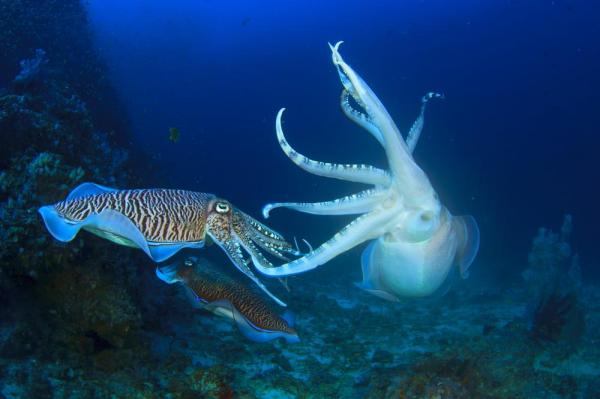
SYDNEY, July 28 (UPI) — If a male cuttlefish looks angry, he probably is angry. New research suggests cuttlefish don’t play emotional games. They’re not bluffers. If they want to fight, they’ll let you know. If they just want to size you up, they’ll make that clear, too.
Male giant Australian cuttlefish, Sepia apama, are notoriously aggressive when battling over the chance to mate with a desirable female. And they match their physical aggression — the actual fighting — with demonstrative displays of aggression, rapidly changing colors and executing unique movement of their arms and body.
A tussle between two moody cuttlefish can last upwards of 20 minutes.
But not all confrontations turn physical. New research suggests the patterns displayed early in a clash can predict the patterns that will be displayed later, and in turn, whether or not a shouting match of sorts is likely to come to blows or not.
By filming and studying cuttlefish conflicts, a team of researchers from Australia were able to decode the species’ display patterns, ranking them from least to most likely to inspire physical contact.
Frontal displays are the most basic form visible aggression, these are mostly used to get a feel for their rival’s mood. Shovel and lateral displays, when a cuttlefish’s mantle is raised and visible, offer patterns of escalation.
With the mantle raised and the arms extended, the cuttlefish’s body takes on the shape of shovel. A lateral display is similar, but with one arm broadened and the rest stretched sideways.
“Such signalling has most likely evolved so that rivals of the same species can communicate varying levels of aggression, providing opponents with numerous opportunities to make tactical decisions about escalating or withdrawing from a contest,” lead researcher Alexandra Schnell, a scientist at the Macquarie University in Australia, said in a news release.
“Rival cuttlefish are likely to benefit from signalling and receiving multiple displays through the ability to determine the aggressive intent of the opponent and to predict whether an attack is imminent.”
Scientists say the fact that cuttlefish, a group of invertebrates, use hierarchical threats similar to distantly related vertebrate species, is proof of the evolutionary pressure to accurately express aggression.
Researchers published their survey of cuttlefish aggression in the journal Behavioral Ecology and Sociobiology.





